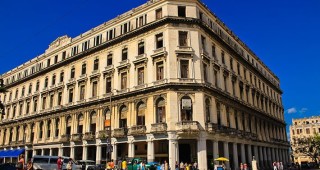
Santa María is the most popular beach among both Habaneros and visitors. It has lodgings, restaurants, watersports hire, grocery stores and a pharmacy. As with the other beahes, it boasts soft, white sand.

Santa María is the most popular beach among both Habaneros and visitors. It has lodgings, restaurants, watersports hire, grocery stores and a pharmacy. As with the other beahes, it boasts soft, white sand.

 4
4Located on Avenida de los Presidentes, this is one of the most lavish monuments in the city. Its bas-reliefs show important moments in the life of José Miguel Gómez, president of the Republic of Cuba …

 5
5While the Floridita has its detractors, it is probably worth stopping in for a daiquiri just because it is there. It has certainly been around the block since it first opened its doors over 200 years …
 Traditional BarAdmission: FreeOpen: Open 11am-midnight daily
Traditional BarAdmission: FreeOpen: Open 11am-midnight daily $48 - $83ROOMS: 25Obispo #557, esq. a Monserrat, Habana Vieja
$48 - $83ROOMS: 25Obispo #557, esq. a Monserrat, Habana Vieja 
 4
4Avenida Paseo, with large trees on both sides and a wide promenade with topiary and benches, is one of Havana’s most classy streets. There are luxurious mansions on both sides of the street, including …

 4
4The América Theatre is one of the most interesting architectural works in Havana. It first opened on March 29, 1941 and is part of a large building complex located on one of Central Havana’s main comm …
 Art Deco
Art Deco 
 4
4Located on the north-east corner of the Plaza de la Catedral, this mid18th-century building is unusual in having three façades: the main one on Empedrado and the other two facing Mercaderes and the sq …

 4
4Tucked into the northwest corner of the plaza, the relatively austere gallery occupies three levels of a partially restored 18th-century townhouse mansion. It holds temporary exhibitions of both renow …

 4
4Owned by Julián de Zulueta, construction work began in 1890 according to the project designed by architect Pedro Tomé Veracruisse; however, still unfinished, it was sold to Andrés Gómez Mena, who comp …
 EclecticAdmission: n-aLimited by Neptuno, Monserrate, Obispo and Zulueta Streets, Habana Vieja
EclecticAdmission: n-aLimited by Neptuno, Monserrate, Obispo and Zulueta Streets, Habana Vieja 
 4
4This beautiful church and convent was built in Neo=\-Gothic style in 1874 and was a private girls’ school until 1961. The patio and chapel have beautiful wooden ceilings, notable stained-glass windows …
 OtherOpen: 8am-5pm Mon-Fri; 5-7pm Sat; 8-11am SunSan Lázaro #805 entre Oquendo y Lucena
OtherOpen: 8am-5pm Mon-Fri; 5-7pm Sat; 8-11am SunSan Lázaro #805 entre Oquendo y Lucena 
 4
4The idea of building this square emerged in the 1940s, when an international contest was organized to erect a monument to honor José Martí, Cuba’s National Hero. In 1943 the project was finally approv …
 ModernAdmission: CUC 3Open: 9am-4:30pm Mon-SatPaseo y Avenida de la Independencia (Boyeros)
ModernAdmission: CUC 3Open: 9am-4:30pm Mon-SatPaseo y Avenida de la Independencia (Boyeros) 
 4
4Elegant and simple, this Romanesque-style theater opened in 1884 as Teatro Irijoa and changed its name to Teatro Martí in 1900. Because of its location in Habana Vieja and its great acoustics, it achi …